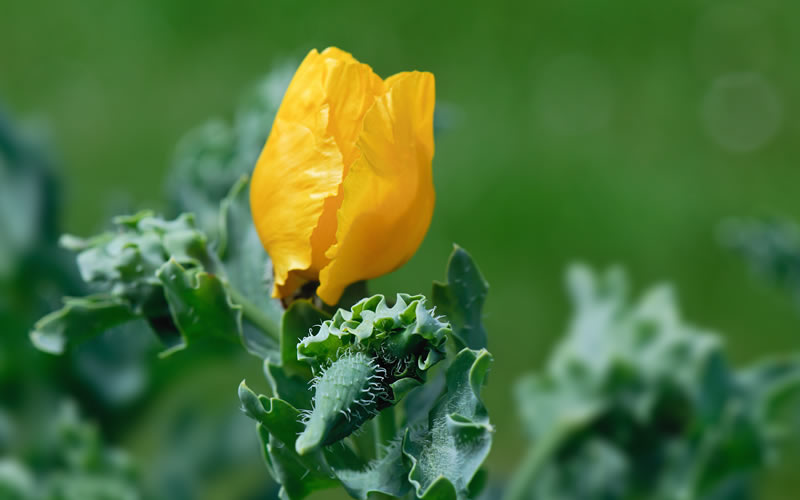When you think of the poppy, do you envisage a waving sea of red blossoms, such as in the classic scene from the film The Wizard of Oz (1939)? This flower has been cultivated by humans for thousands of years. You, too, can accomplish such a colorful array even in drought prone areas with the help of the hardy horned poppy.
The horned poppy or sea poppy (genus Glaucium) is native to Europe, Asia, the Middle East, and northern Africa. The common name “horned poppy” encompasses about 25 distinct species. The name is derived from the horn shaped feature atop the plant’s seed bearing fruit. While part of the same floral family, the horned poppy is distinct from its cousins the “true” poppy and opium poppy.

Appearance
Stems grow up to 3 feet in height, sporting delicate two inch flowers with tissue-paper-like petals in shades of red, yellow, and orange. Each flower lasts only one day. However, blooms appear in succession. Therefore, the plant will typically bloom constantly for a series of weeks. The grey green leaves are thick, hairy, and lobed, often growing in a rosette shape at the base of the plant. The stems and blooms tower above the leafy foliage.
Environment
Horned poppies are incredible survivors. They can handle salty, sandy soil with ease. In fact, in their native environments, some horned poppies grow directly on the beach. They can be successfully grown in USDA hardiness zones 3 through 10.
Varieties
The most common horned poppies selected for commercial cultivation include:
The yellow horned poppy is native to the beaches of Britain and Europe and has become well established in the United States. As its name suggests, its bloom is yellow in color.
The red horned poppy is smaller than other varieties. Its blooms are bright red with black spots at the base. This is the classic poppy.
Care
Plant in full sun in an area with dry soil. Most gardeners treat all horned poppies as annual plants. As such, most are direct sown from seed in late autumn or early summer. Some species require a full year before germination. Thin to a spacing of about one foot to 18 inches, as desired. The plants can be started indoors and transplanted after the last frost, but sowing outdoors usually yields the best results.
After planting, horned poppies are basically care-free. If desired, lightly apply fertilizer once yearly, in the spring.
Benefits
Horned poppies have been used to reduce beach erosion, and are likewise good for erosion control in other sandy environments, including dunes. They are also salt tolerant, making them ideal for revitalizing areas that have suffered soil salinization. Their affinity for dry soils makes them ideal for the drought garden. The unusual, decorative seed pods can be dried and used in floral arrangements.
Precautions
Horned poppies exude a yellow natural latex when the leaves or stems are damaged. Individuals with synthetic latex allergies, with spina bifida, and those who have had multiple surgeries may be sensitive to natural latex. Caution should be used when coming in contact with this plant.
Horned Poppies Quick Facts
Height: Up to 3 feet
Lifespan: Annual, biennial, or perennial
Flowers: Poppy-like blooms in yellow, orange, or red
Seeds: Enveloped in pods up to one foot long
Leaves: Hairy, thick, and lobed
Regions: Zones 3 to 10
Genus: Glaucium
Species: G. flavum, G. corniculatum, and others
Resources
Burrell, C. Colston. “Horned Poppy, Sea Poppy.” How Stuff Works.
Hattatt, Lance. Encyclopedia of Garden Plants and Flowers. 1998.
“Horned Poppy, Plant.” Encyclopaedia Britannica.
“How to Grow Glaucium Plants – Guide to Growing Horned Poppy and Sea Poppy.” Gardeners HQ.
“Latex.” Wikipedia.
